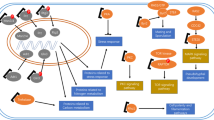Abstract
14-3-3 Proteins are found to bind to a growing number of eukaryotic proteins and evidence is accumulating that 14-3-3 proteins serve as modulators of enzyme activity. Several 14-3-3 protein recognition motifs have been identified and an increasing number of target proteins have been found to contain more than one binding site for a 14-3-3 protein. It is thus possible that 14-3-3 dimers function as clamps that simultaneously bind to two motifs within a single binding partner. Phosphorylation of a number of binding motifs has been shown to increase the affinity for 14-3-3 proteins but other mechanisms also regulate the association. It has recently been demonstrated that fusicoccin induces a tight association between 14-3-3 proteins and the plant plasma membrane H+-ATPase. Phorbol esters and other hydrophobic molecules may have a similar effect on the association between 14-3-3 proteins and specific binding partners.
Similar content being viewed by others
Author information
Authors and Affiliations
Corresponding author
Rights and permissions
About this article
Cite this article
Palmgren, M.G., Fuglsang, A.T. & Jahn, T. Deciphering the role of 14-3-3 proteins. EBO 3, 1–17 (1998). https://doi.org/10.1007/s00898-998-0004-4
Received:
Accepted:
Issue Date:
DOI: https://doi.org/10.1007/s00898-998-0004-4




